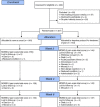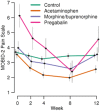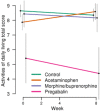Impact of a stepwise protocol for treating pain on pain intensity in nursing home patients with dementia: a cluster randomized trial
- PMID: 24819710
- PMCID: PMC4232010
- DOI: 10.1002/ejp.523
Impact of a stepwise protocol for treating pain on pain intensity in nursing home patients with dementia: a cluster randomized trial
Abstract
Background: Pain is frequent and distressing in people with dementia, but no randomized controlled trials have evaluated the effect of analgesic treatment on pain intensity as a key outcome.
Methods: Three hundred fifty-two people with dementia and significant agitation from 60 nursing home units were included in this study. These units, representing 18 nursing homes in western Norway, were randomized to a stepwise protocol of treating pain (SPTP) or usual care. The SPTP group received acetaminophen, morphine, buprenorphine transdermal patch and pregabalin for 8 weeks, with a 4-week washout period. Medications were governed by the SPTP and each participant's existing prescriptions. We obtained pain intensity scores from 327 patients (intervention n = 164, control n = 163) at five time points assessed by the primary outcome measure, Mobilization-Observation-Behaviour-Intensity-Dementia-2 (MOBID-2) Pain Scale. The secondary outcome was activities of daily living (ADL). We used a linear intercept mixed model in a two-way repeated measures configuration to assess change over time and between groups.
Results: The SPTP conferred significant benefit in MOBID-2 scores compared with the control group [average treatment effect (ATE) -1.388; p < 0.001] at week 8, and MOBID-2 scores worsened during the washout period (ATE = -0.701; p = 0.022). Examining different analgesic treatments, benefit was conferred to patients receiving acetaminophen compared with the controls at week 2 (ATE = -0.663; p = 0.010), continuing to increase until week 8 (ATE = -1.297; p < 0.001). Although there were no overall improvements in ADL, an increase was seen in the group receiving acetaminophen (ATE = +1.0; p = 0.022).
Conclusion: Pain medication significantly improved pain in the intervention group, with indications that acetaminophen also improved ADL function.
© 2014 The Authors. European Journal of Pain published by John Wiley & Sons Ltd on behalf of European Pain Federation - EFIC®.
Figures






Comment in
-
A high-quality RCT documents that elderly with dementia, the most neglected pain patients, have effective and safe pain relief from paracetamol alone or with buprenorphine patch.Eur J Pain. 2014 Nov;18(10):1363-4. doi: 10.1002/ejp.558. Eur J Pain. 2014. PMID: 25303611 No abstract available.
Similar articles
-
The response of agitated behavior to pain management in persons with dementia.Am J Geriatr Psychiatry. 2014 Jul;22(7):708-17. doi: 10.1016/j.jagp.2012.12.006. Epub 2013 Apr 20. Am J Geriatr Psychiatry. 2014. PMID: 23611363 Clinical Trial.
-
Efficacy of treating pain to reduce behavioural disturbances in residents of nursing homes with dementia: cluster randomised clinical trial.BMJ. 2011 Jul 15;343:d4065. doi: 10.1136/bmj.d4065. BMJ. 2011. PMID: 21765198 Free PMC article. Clinical Trial.
-
Effects of pain treatment on sleep in nursing home patients with dementia and depression: A multicenter placebo-controlled randomized clinical trial.Int J Geriatr Psychiatry. 2018 Apr;33(4):663-670. doi: 10.1002/gps.4839. Epub 2017 Dec 28. Int J Geriatr Psychiatry. 2018. PMID: 29282768 Free PMC article. Clinical Trial.
-
Analgesics use and withdrawal in people with dementia - a register-based Danish study and a systematic review.Dan Med J. 2019 Dec;66(12):A5578. Dan Med J. 2019. PMID: 31791478
-
Analgesic treatments in people with dementia - how safe are they? A systematic review.Expert Opin Drug Saf. 2019 Jun;18(6):511-522. doi: 10.1080/14740338.2019.1614166. Epub 2019 May 16. Expert Opin Drug Saf. 2019. PMID: 31038371
Cited by
-
Time Trends in Opioid Use by Dementia Severity in Long-Term Care Nursing Home Residents.J Am Med Dir Assoc. 2021 Jan;22(1):124-131.e1. doi: 10.1016/j.jamda.2020.04.029. Epub 2020 Jun 27. J Am Med Dir Assoc. 2021. PMID: 32605815 Free PMC article.
-
[Treatment of pain in people with dementia].Z Gerontol Geriatr. 2019 Oct;52(6):607-622. doi: 10.1007/s00391-019-01578-4. Epub 2019 Jul 25. Z Gerontol Geriatr. 2019. PMID: 31346680 German.
-
Implementation and Evaluation of an Acute Care Multicomponent Intervention for Dementia-Related Behavioral Expressions.J Gerontol Nurs. 2021 Sep;47(9):21-30. doi: 10.3928/00989134-20210803-02. Epub 2021 Sep 1. J Gerontol Nurs. 2021. PMID: 34432573 Free PMC article.
-
COSMOS--improving the quality of life in nursing home patients: protocol for an effectiveness-implementation cluster randomized clinical hybrid trial.Implement Sci. 2015 Sep 15;10:131. doi: 10.1186/s13012-015-0310-5. Implement Sci. 2015. PMID: 26374231 Free PMC article. Clinical Trial.
-
Psychometric Evaluation of the MOBID Dementia Pain Scale in U.S. Nursing Homes.Pain Manag Nurs. 2019 Jun;20(3):253-260. doi: 10.1016/j.pmn.2018.11.062. Epub 2019 May 10. Pain Manag Nurs. 2019. PMID: 31085096 Free PMC article.
References
-
- Achterberg WP, Gambassi G, Finne-Soveri H, Liperoti R, Noro A, Frijters DH, Cherubini A, Dell'aquila H, Ribbe MW. Pain in European long-term care facilities: Cross-national study in Finland, Italy and the Netherlands. Pain. 2010;148:70–74. - PubMed
-
- Achterberg WP, Pot AM, Scherder EJ, Ribbe MW. Pain in the nursing home: Assessment and treatment on different types of care wards. J Pain Symptom Manage. 2007;34:480–487. - PubMed
-
- AGS Panel on Persistent Pain in Older Persons. Pharmacological management of persistent pain in older persons. J Am Geriatr Soc. 2009;57:1331–1366. - PubMed
Publication types
MeSH terms
Substances
LinkOut - more resources
Full Text Sources
Other Literature Sources
Medical
Research Materials

